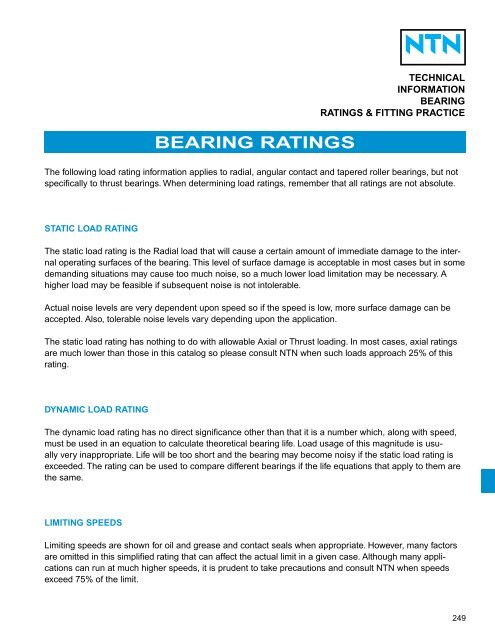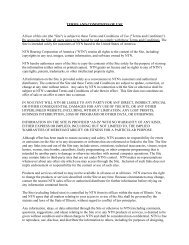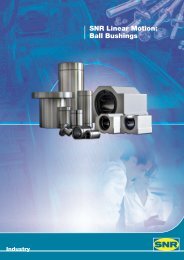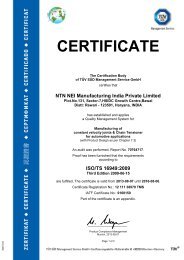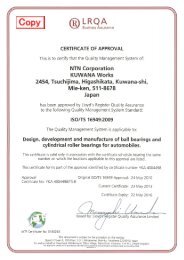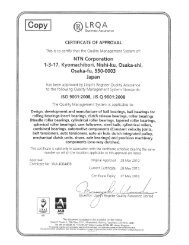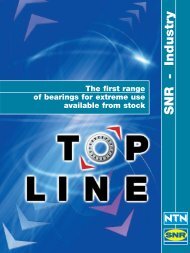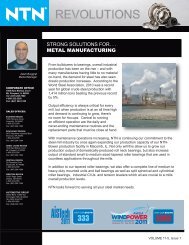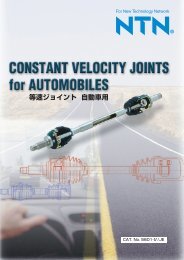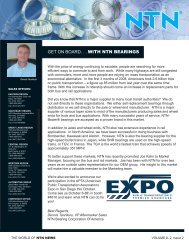- Page 1 and 2:
BALL AND ROLLER BEARINGS B A S d N
- Page 3 and 4:
Offer; Acceptance. These terms and
- Page 5 and 6:
4 IN NORTH AMERICA NTN is one of th
- Page 7 and 8:
6 HISTORY 1918 Began research and m
- Page 9 and 10:
BEARING CLASSIFICATION 8 CLASSIFICA
- Page 11 and 12:
SINGLE ROW RADIAL BALL BEARINGS are
- Page 13 and 14:
12 MICRO BEARING NUMBERING SYSTEM O
- Page 15 and 16:
14 Notes
- Page 17 and 18:
1. PREFIX TS2: Heat stabilization f
- Page 19 and 20:
18 SERIES 600 Double Shielded ZZ Do
- Page 21 and 22:
20 SERIES 60 Single Shielded 60Z Do
- Page 23 and 24:
22 SERIES 60 Open Type 60 Units: IN
- Page 25 and 26:
24 SERIES 62 Single Shielded 62Z Do
- Page 27 and 28:
26 SERIES 62 Single Shielded 62Z Do
- Page 29 and 30:
28 SERIES 63 Single Shielded 63Z Do
- Page 31 and 32:
30 SERIES 64 Double Sealed 64LLB (C
- Page 33 and 34:
32 SERIES BL2 Maximum Type Single S
- Page 35 and 36:
34 SERIES BL3 Maximum Type Single S
- Page 37 and 38:
36 SERIES TMB2 Single Shielded TMB2
- Page 39 and 40:
38 SERIES TMB2 Single Shielded TMB2
- Page 41 and 42:
40 SERIES TMB3 Single Shielded TMB3
- Page 43 and 44:
42 Notes
- Page 45 and 46:
44 SERIES 72B 40° Contact Angle 72
- Page 47 and 48:
46 SERIES 74B 40° Contact Angle 74
- Page 49 and 50:
48 SERIES 72 30° Contact Angle 72
- Page 51 and 52:
50 SERIES 70C High Precision Grade
- Page 53 and 54:
52 SERIES 73C High Precision Grade
- Page 55 and 56:
54 SERIES 32 33 MAXIMUM TYPE 32 33
- Page 57 and 58:
56 Double Row Sealed and Shielded T
- Page 59 and 60:
58 SERIES 12 12K Cylindrical Bore 1
- Page 61 and 62:
60 SERIES 13 13K Cylindrical Bore 1
- Page 63 and 64:
62 CYLINDRICAL ROLLER BEARING NUMBE
- Page 65 and 66:
64 SERIES NF2 • N2 NJ2 • NU2 NF
- Page 67 and 68:
66 SERIES NF3 • N3 NJ3 • NU3 NF
- Page 69 and 70:
68 SERIES NF4 • N4 NJ4 • NU4 NF
- Page 71 and 72:
70 SERIES NJ22 NU22 NJ22 NU22 Units
- Page 73 and 74:
72 SERIES NJ23 NU23 NJ23 NU23 Units
- Page 75 and 76:
74 SERIES NN30 NN30K PRECISION AND
- Page 77 and 78:
76 SERIES 4T Units: INCHES Millimet
- Page 79 and 80:
78 SERIES 4T Units: INCHES Millimet
- Page 81 and 82:
80 SERIES 4T Units: INCHES Millimet
- Page 83 and 84:
82 SERIES 4T Units: INCHES Millimet
- Page 85 and 86:
84 SERIES 4T Units: INCHES Millime
- Page 87 and 88:
86 SERIES 4T Units: INCHES Millime
- Page 89 and 90:
88 SERIES 4T Units: INCHES Millime
- Page 91 and 92:
90 SERIES 4T Units: INCHES Millime
- Page 93 and 94:
92 SERIES 4T Units: INCHES Millimet
- Page 95 and 96:
94 BEARING WEIGHTS 4T-335 SERIES 4T
- Page 97 and 98:
96 BEARING WEIGHTS 4T-15103S / 1524
- Page 99 and 100:
98 SERIES METRIC ISO Units: INCHES
- Page 101 and 102:
100 SERIES METRIC ISO Units: INCHES
- Page 103 and 104:
102 SERIES METRIC ISO Units: INCHES
- Page 105 and 106:
TAPERED ROLLER BEARING CARTRIDGE 10
- Page 107 and 108:
106 SPHERICAL ROLLER BEARING NUMBER
- Page 109 and 110:
108 SERIES 222 In this series, mach
- Page 111 and 112:
110 SERIES 230 Cylindrical Bore 230
- Page 113 and 114:
112 SERIES 232 Use Suffix L1 for br
- Page 115 and 116:
114 SERIES 240 Units: INCHES Millim
- Page 117 and 118:
SERIES 223 UAVS1 SHAKER SCREEN BEAR
- Page 119 and 120:
118 BEARING WEIGHTS Bearing Series
- Page 121 and 122:
NTN ADAPTERS • Accurate and finel
- Page 123 and 124:
122 SERIES H 23 HE23 HS23 HA23 Adap
- Page 125 and 126:
LOCKNUTS AND LOCKWASHERS For Bearin
- Page 127 and 128:
LOCKNUTS AND LOCKWASHERS 126 WEIGHT
- Page 129 and 130:
128 SERIES 511 Units: INCHES Millim
- Page 131 and 132:
130 SERIES 29 Units: INCHES Millime
- Page 133 and 134:
132 SERIES 294 Units: INCHES Millim
- Page 135 and 136:
Ultra-Class 134 MOUNTED UNIT SELECT
- Page 137 and 138:
136 SERIES UCPL SET SCREW TYPE Part
- Page 139 and 140:
Part Number 138 SERIES ARP SET SCRE
- Page 141 and 142:
140 SERIES UELP ECCENTRIC LOCKING C
- Page 143 and 144:
142 SERIES JELP ECCENTRIC LOCKING C
- Page 145 and 146:
144 SERIES UCFLU SET SCREW TYPE Par
- Page 147 and 148:
146 SERIES ARFLU SET SCREW TYPE Par
- Page 149 and 150:
148 SERIES JELFLU ECCENTRIC LOCKING
- Page 151 and 152:
150 SERIES UCFUX SET SCREW TYPE Par
- Page 153 and 154:
152 SERIES ARFU SET SCREW TYPE Part
- Page 155 and 156:
154 BEARING WEIGHTS UCP Series UCP-
- Page 157 and 158:
156 SERIES UCP2 SET SCREW TYPE Shaf
- Page 159 and 160:
158 SERIES UCPL2 SET SCREW TYPE Sha
- Page 161 and 162:
160 SERIES UCPX SET SCREW TYPE Shaf
- Page 163 and 164:
162 SERIES ASPL2 SET SCREW TYPE Sha
- Page 165 and 166:
164 SERIES UELP2 62 ECCENTRIC LOCKI
- Page 167 and 168:
166 SERIES UELP3 ECCENTRIC LOCKING
- Page 169 and 170:
168 SERIES AELP2 ECCENTRIC LOCKING
- Page 171 and 172:
170 SERIES AELPP2 ECCENTRIC LOCKING
- Page 173 and 174:
172 BEARING WEIGHTS UCP2 SERIES UCP
- Page 175 and 176:
174 SERIES UCFL2 SET SCREW TYPE Sha
- Page 177 and 178:
176 SERIES UCFLX SET SCREW TYPE Sha
- Page 179 and 180:
178 SERIES UELFL3 ECCENTRIC LOCKING
- Page 181 and 182:
180 SERIES AELFL2 ECCENTRIC LOCKING
- Page 183 and 184:
182 SERIES ASFD2 SET SCREW TYPE Sha
- Page 185 and 186:
184 SERIES JELFD2 ECCENTRIC LOCKING
- Page 187 and 188:
186 SERIES AELPFL2 ECCENTRIC LOCKIN
- Page 189 and 190:
188 SERIES ASPF2 SET SCREW TYPE Sha
- Page 191 and 192:
190 SERIES JELPF2 ECCENTRIC LOCKING
- Page 193 and 194:
192 SERIES UCF2 SET SCREW TYPE Shaf
- Page 195 and 196:
194 SERIES UCF3 SET SCREW TYPE Shaf
- Page 197 and 198:
196 SERIES UCFX SET SCREW TYPE Shaf
- Page 199 and 200: 198 SERIES UELF3 ECCENTRIC LOCKING
- Page 201 and 202: 200 SERIES UKF2 ADAPTER TYPE Shaft
- Page 203 and 204: 202 BEARING WEIGHTS JELFL208D1 ....
- Page 205 and 206: 204 SERIES Units: Millimeters INCHE
- Page 207 and 208: 206 SERIES UCX SET SCREW TYPE Units
- Page 209 and 210: 208 SERIES AR2 SET SCREW TYPE Units
- Page 211 and 212: 210 SERIES UCS3 SET SCREW TYPE Unit
- Page 213 and 214: 212 SERIES UEL3 ECCENTRIC LOCKING C
- Page 215 and 216: 214 SERIES JEL2 ECCENTRIC LOCKING C
- Page 217 and 218: 216 SERIES UK2 ADAPTER TYPE UK2...D
- Page 219 and 220: 218 BEARING WEIGHTS UC206-104D1 ...
- Page 221 and 222: 220 BEARING SPEED LIMITS AS2 SERIES
- Page 223 and 224: 222 SERIES 1AS-7AS Units: INCHES Be
- Page 225 and 226: 224 SERIES 1AH-3AH Units: INCHES HE
- Page 227 and 228: 226 SPW PILLOW BLOCKS Shaft Diamete
- Page 229 and 230: 228 SPAW PILLOW BLOCKS ➊ ➊ Unit
- Page 231 and 232: 230 SFCW FLANGE BLOCKS Shaft Diamet
- Page 233 and 234: 232 SERIES SAF 225 SAF 226 ADAPTER
- Page 235 and 236: 234 SERIES SAF222 SAF223 CYLINDRICA
- Page 237 and 238: 236 SERIES SAFS225 ADAPTER MOUNTING
- Page 239 and 240: 238 Notes
- Page 241 and 242: TECHNICAL INFORMATION Bearing Mater
- Page 243 and 244: TECHNICAL INFORMATION Lubrication B
- Page 245 and 246: TECHNICAL INFORMATION 244 Trouble O
- Page 247 and 248: TECHNICAL INFORMATION BEARING NOMEN
- Page 249: TECHNICAL INFORMATION BEARING NOMEN
- Page 253 and 254: TECHNICAL INFORMATION BEARING RATIN
- Page 255 and 256: TOLERANCE TABLES 254 TOLERANCES Def
- Page 257 and 258: TOLERANCE TABLES BASIC BORE DIAMETE
- Page 259 and 260: TOLERANCE TABLES BASIC BORE DIAMETE
- Page 261 and 262: TOLERANCE TABLES Bore Diameter d no
- Page 263 and 264: TOLERANCE TABLES 262 Tolerance limi
- Page 265 and 266: TOLERANCE TABLES 264 Tolerance limi
- Page 267 and 268: CLEARANCE TABLES 266 Standard toler
- Page 269 and 270: CLEARANCE TABLES 268 Standard toler
- Page 271 and 272: INTERCHANGE DATA 270 SEALS, SHIELDS
- Page 273 and 274: INTERCHANGE DATA 272 CYLINDRICAL RO
- Page 275 and 276: INTERCHANGE DATA 274 DISC HARROW BE
- Page 277 and 278: ENGLISH/METRIC CONVERSION CHART 276
- Page 279 and 280: NTN Terms and Conditions of Sale ..
- Page 282: NTN Bearing Corporation of Canada C


